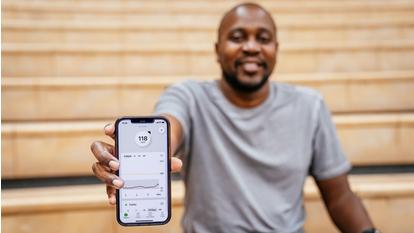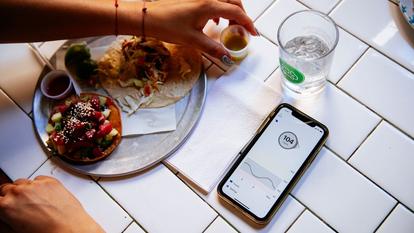
Benefits of continuous glucose monitoring vs. blood glucose monitoring
What is the difference between CGM and BGM? Blood Glucose Meters (BGM) measure glucose levels at a single moment in time, while Dexcom Continuous Glucose Monitoring (CGM) systems continually check glucose levels throughout the day and night and can alert you if your glucose levels go too high or too low.

No more fingersticks!*
BGMs require fingersticks to give you a single reading at a moment in time. CGMs, on the other hand, provide continuous glucose readings 24/7 to your compatible smart device‡ without fingersticks.* CGMs also have proven accuracy1 without painful and inconvenient fingersticks. Say goodbye to fingersticks!
*For the Dexcom CGM, if your glucose alerts and readings from your CGM do not match symptoms or expectations, use a blood glucose meter to make your diabetes treatment decisions. Please see the indications for use for all other CGM system to understand the important safety information
Benefits of CGM

Glucose numbers 24/7
Continuous Glucose Monitoring Systems measure your glucose numbers 24/7 without fingersticks*, giving you real-time information to make better diabetes decisions. BGMs only give you a single glucose reading each time you prick your finger.
* Fingersticks required for diabetes treatment decisions if symptoms or expectations do not match readings.

More informed diabetes decisions
CGM systems show the direction your glucose is heading – up, down, or steady – so you can see how food, activity, and insulin affect your levels. No more guessing! CGMs allow you to proactively manage your diabetes.

Lowers A1C
The Dexcom Continuous Glucose Monitoring Systems, such as the Dexcom G6 and G7, are clinically proven to lower A1C,1-5 reduce hyper- and hypoglycemia and increase time in range, helping you stay in better control of your diabetes.
Learn more about Dexcom CGM Systems
Watch and learn more about the value and benefits of CGM.
How Dexcom CGM works
The benefits of Dexcom CGM
8 reasons to get Dexcom CGM

Get started with Dexcom G7
If you are a new Dexcom user, fill out the Get Started form to get a free benefits check.
If you are a current Dexcom G6 user, please speak to your doctor about getting a prescription for Dexcom G7. Check out the FAQ for further details
*For the Dexcom G6 and Dexcom G7, if your glucose alerts and readings from your CGM do not match symptoms or expectations, use a blood glucose meter to make your diabetes treatment decisions. Please see the indications for use for all other CGM system to understand the important safety information. ‡ For a list of compatible devices, visit www.dexcom.com/compatibility.
1 Welsh JB, et al. J Diabetes Sci Technol. 2022:19322968221099879. 2 Beck, RW, et al. JAMA. 2017;317(4):371-378. 3 Beck RW, et al. Ann Intern Med. 2017;167(6):365-374. 4 Martens T, et al. JAMA. 2021;325(22):2262-2272. 5 Laffel LM, et al. JAMA. 2020;323(23):2388-2396.
BRIEF SAFETY STATEMENT Failure to use the Dexcom G6 Continuous Glucose Monitoring System (G6) and its components according to the instructions for use provided with your device and available at https://www.dexcom.com/safety-information and to properly consider all indications, contraindications, warnings, precautions, and cautions in those instructions for use may result in you missing a severe hypoglycemia (low blood glucose) or hyperglycemia (high blood glucose) occurrence and/or making a treatment decision that may result in injury. If your glucose alerts and readings from the G6 do not match symptoms or expectations or you’re taking over the recommended maximum dosage amount of 1000mg of acetaminophen every 6 hours, use a blood glucose meter to make diabetes treatment decisions. Seek medical advice and attention when appropriate, including for any medical emergency.
Failure to use the Dexcom G7 Continuous Glucose Monitoring System (G7) and its components according to the instructions for use provided with your device and available at https://www.dexcom.com/safety-information and to properly consider all indications, contraindications, warnings, precautions, and cautions in those instructions for use may result in you missing a severe hypoglycemia (low blood glucose) or hyperglycemia (high blood glucose) occurrence and/or making a treatment decision that may result in injury. If your glucose alerts and readings from the G7 do not match symptoms, use a blood glucose meter to make diabetes treatment decisions. Seek medical advice and attention when appropriate, including for any medical emergency.
